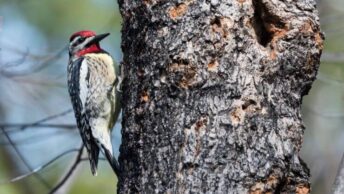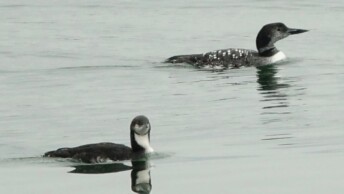Maryland is a wonderful place to look for birds that brighten the landscape with shades of blue. Whether you’re walking along a forest trail or sitting near a backyard feeder, you can find everything from the cheerful Eastern Bluebird to the flashy Indigo Bunting. Even the Belted Kingfisher, with its slate-blue back and rattling call, feels like a special sight as it hunts along rivers and ponds.
During spring and fall migration, more colorful visitors pass through, including the delicate Cerulean Warbler and the striking Black-throated Blue Warbler. These birds bring energy and beauty to woodlands, fields, and wetlands across the state. In this article, you’ll learn about some of Maryland’s most interesting blue birds, where to find them, and how to tell them apart. With a little patience and curiosity, you’ll soon notice how much these vibrant birds enrich every season outdoors.
1. Eastern Bluebird
- Scientific name: Sialia sialis
- Life span: 6–10 years
- Size: 6.3–8.3 in (16–21 cm)
- Weight: 1.0–1.1 oz (28–32 g)
- Wingspan: 9.8–12.6 in (25–32 cm)
- Status: Least Concern
- State status: Breeding and common
- Migratory behaviour: Many stay year-round; some migrate south in winter.
The Eastern Bluebird is widely found across eastern North America, from southern Canada down to Florida and west into parts of Texas and Colorado. Males show off vivid blue wings and back that contrast beautifully with a warm reddish-orange throat and breast. Females are softer in color, with grayish-blue wings and pale underparts.
You’ll often see them perched on fence posts or wires, flicking their tails while watching for movement below. Their gentle, musical calls add warmth to open fields and meadows.
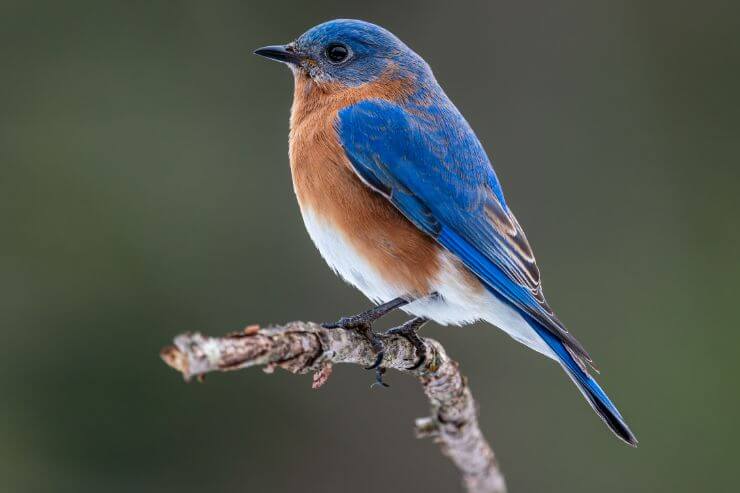
Eastern Bluebirds build cup-shaped nests inside tree cavities or nest boxes. Females do most of the weaving, using grasses and pine needles to line the nest. Males stay nearby, fluttering and singing to defend the territory. They often raise multiple broods each season, returning to the same open spaces with scattered trees year after year.
They eat insects in warmer months, capturing grasshoppers, beetles, and caterpillars by swooping down from low perches. In winter, they switch to berries like dogwood and holly. You’ll often see them perched on wires, scanning the ground carefully for the slightest movement before dropping to grab hidden prey.
Once declining due to loss of nest sites and competition with starlings, bluebirds have rebounded thanks to widespread nest box programs. Their recovery is one of North America’s most inspiring conservation stories. People still monitor boxes each year to ensure their numbers remain healthy and stable.
2. Indigo Bunting
- Scientific name: Passerina cyanea
- Life span: Up to 10 years
- Size: 4.7–5.1 in / 12–13 cm
- Weight: 0.4–0.6 oz / 12–18 g
- Wingspan: 7.5–8.7 in / 19–22 cm
- Status: Least Concern
- State status: Migratory and common
- Migratory behaviour: Leaves by October; winters in Central America.
The Indigo Bunting breeds throughout the eastern and central United States and migrates to Central America for winter. Males are stunning in summer, wearing an even coat of brilliant, almost electric blue from head to tail. In duller light, they can look dark, but sunlight reveals their hidden brightness.
Females and young birds are plain warm brown, blending into brush and weedy fields. These little finches often perch high to deliver their sweet, steady songs that fill summer mornings.
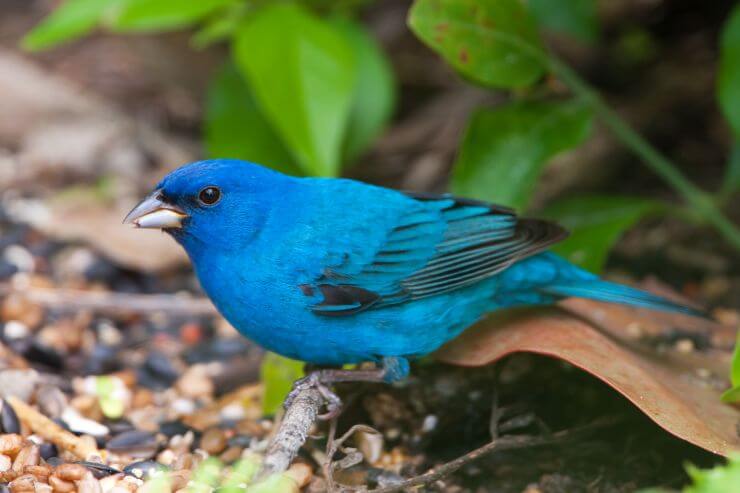
Indigo Buntings build well-hidden cup nests low in dense shrubs or young trees. Females weave the structure carefully, tucking it securely in the foliage. Males spend most of their time singing bright, musical phrases from exposed perches high above, warning other males to stay away from their chosen territory.
They feed mostly on seeds from grasses and weeds through summer and fall. While raising young, they also catch small insects, which provide needed protein. Indigo Buntings forage low among thickets and field edges, slipping quietly in and out of cover while staying alert to any sudden movement.
Indigo Buntings remain widespread and fairly common across Maryland. Habitat loss and pesticide use pose some concerns, but their ability to use edges and regenerating clearings helps maintain their populations. Conservation efforts focus on preserving shrubby habitats and planting native vegetation that supports insects and seed-producing plants.
3. Tree Swallow
- Scientific name: Tachycineta bicolor
- Life span: 2-3 years
- Size: 4.7–5.9 in (12–15 cm)
- Weight: 0.6–0.9 oz (17–25 g)
- Wingspan: 11.8–13.8 in (30–35 cm)
- Status: Least Concern
- State status: Breeding and common
- Migratory behaviour: Heads south by October; winters in southern U.S. and beyond.
Tree Swallows are widespread across most of North America during the breeding season, especially around wetlands, open fields, and ponds. They have sleek, glossy blue-green backs that catch the sun, setting off bright white underparts. Their small bills and long pointed wings give them a streamlined look that suits their agile flight. Tree Swallows often gather in loose flocks, chattering softly as they swirl over water or perch in rows along wires.
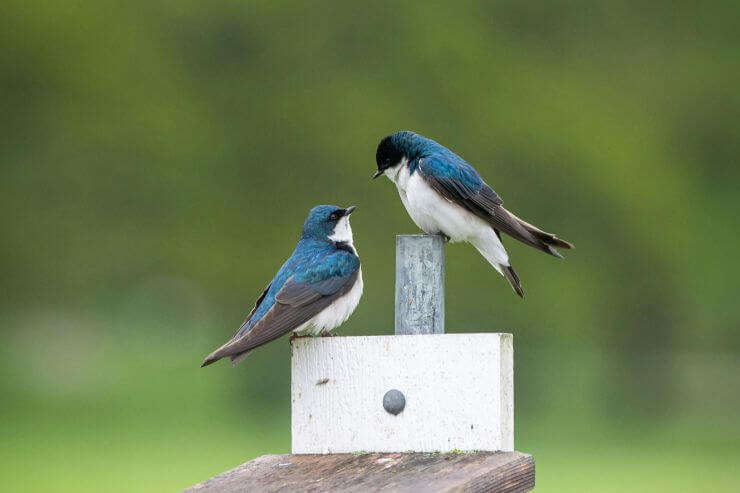
Tree Swallows nest in old woodpecker cavities or nest boxes placed near open water. Both parents bring feathers to line the cup-shaped nest, creating a soft, insulated bed for their young. They defend their chosen site fiercely, chasing away other swallows and potential predators.
They feed mainly on flying insects caught in swift, acrobatic flight. Tree Swallows skim low over ponds and fields, twisting and banking as they snatch insects midair. On cool days, they sometimes perch quietly in flocks along fences or bare branches, waiting for insects to become active again.
Tree Swallows have benefited greatly from nest box programs, which help replace lost natural cavities. They remain common across Maryland wetlands and open fields. Conservation groups monitor boxes each year to track their numbers and ensure clean, safe nesting sites remain available for future generations.
4. Cerulean Warbler
- Scientific name: Setophaga cerulea
- Life span: Up to 6 years
- Size: 4.3 in / 11 cm
- Weight: 0.3 oz / 8.5 g
- Wingspan: 7.9 in / 20 cm
- Status: Near Threatened
- State status: Migratory and rare
- Migratory behaviour: Leaves in August; winters in South America’s Andes.
The Cerulean Warbler breeds in tall, mature deciduous forests across the eastern United States and winters in the Andes of South America. Males wear sky-blue feathers on the head and back, with a white belly and a thin dark line across the throat. Females are more subdued, with bluish-green backs and faint streaks below. Cerulean Warblers spend much of their time high in the canopy, making them a rewarding challenge for birders willing to look up.

Cerulean Warblers build small cup nests on horizontal branches high in the canopy of tall deciduous trees. Females do nearly all the construction alone, weaving bark strips and grass into a neat cradle. Males sing persistently from high perches, defending their territory with a sweet, rising trill.
They eat insects gathered among leaves and twigs. Cerulean Warblers forage high in the treetops, moving quickly between branches. Because they stay above eye level, their sky-blue backs often blend into the bright canopy light, making them challenging and rewarding to spot during breeding or migration.
Cerulean Warblers have declined steeply due to habitat loss and fragmentation. They are considered a priority species for conservation. Efforts focus on preserving large tracts of mature forest and improving conditions along their migratory routes to support their long-term survival across their range.
5. Black-throated Blue Warbler
- Scientific name: Setophaga caerulescens
- Life span: Up to 9 years
- Size: 5.1 in / 13 cm
- Weight: 0.3–0.4 oz / 8–11 g
- Wingspan: 7.5–8.7 in / 19–22 cm
- Status: Least Concern
- State status: Migratory and uncommon
- Migratory behaviour: Migrates south by October to the Caribbean.
Black-throated Blue Warblers breed in northeastern forests, especially in mature hardwood stands with dense understory. Males are striking, with a rich blue back, black face and throat, and crisp white belly that creates a sharp contrast. Females look very different, with warm olive-brown plumage and a soft whitish eyebrow. You’ll often see these warblers moving methodically among leaves, flicking their tails to reveal small white patches, a reliable field mark even when the bird itself is partly hidden.
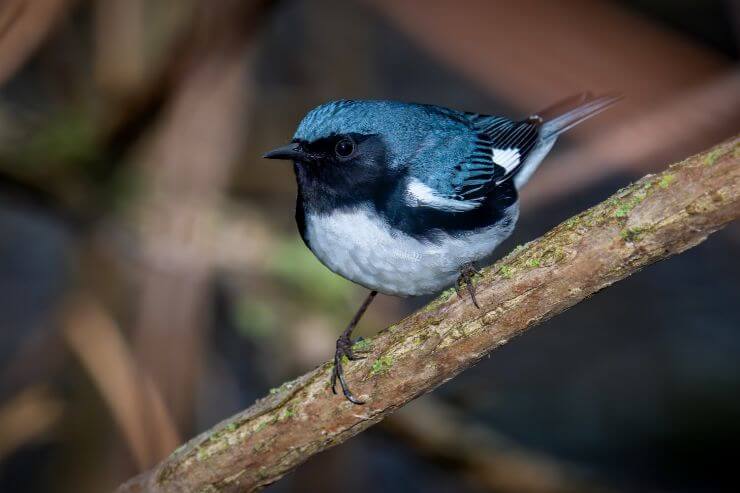
These warblers nest in dense understory shrubs in mature deciduous forests. Females build delicate cup nests low to the ground, often hidden among ferns or young saplings. Males keep watch nearby, singing a buzzy, rising song that carries well through shaded glens and wooded slopes.
They feed on insects and spiders picked carefully from leaves and twigs. Black-throated Blue Warblers forage with deliberate movements, flicking their tails to reveal bright white patches. This unique tail pattern often gives them away even when their bodies stay partly hidden in thick foliage.
They are uncommon migrants in Maryland but breed mainly farther north. Habitat fragmentation in breeding areas is a concern. Conservation efforts emphasize protecting large, unbroken forests that offer the mature understory these warblers need for nesting and foraging successfully through the summer.
6. Blue Grosbeak
- Scientific name: Passerina caerulea
- Life span: Up to 9 years
- Size: 5.5–7.5 in (14–19 cm)
- Weight: 0.9–1.1 oz (26–31 g)
- Wingspan: 10–11 in (25–28 cm)
- Status: Least Concern
- State status: Breeding and uncommon
- Migratory behaviour: Departs by late September for Mexico and Central America.
The Blue Grosbeak nests across the southern United States and up into the lower Midwest, including parts of Maryland. Males have deep, rich blue plumage set off by two warm chestnut wingbars and a thick, strong bill. Females are soft brown with faint streaks and a large bill that hints at their identity. These birds often stay low in dense roadside thickets or shrubby fields, where they can be hard to spot until they rise up to sing from an open perch.
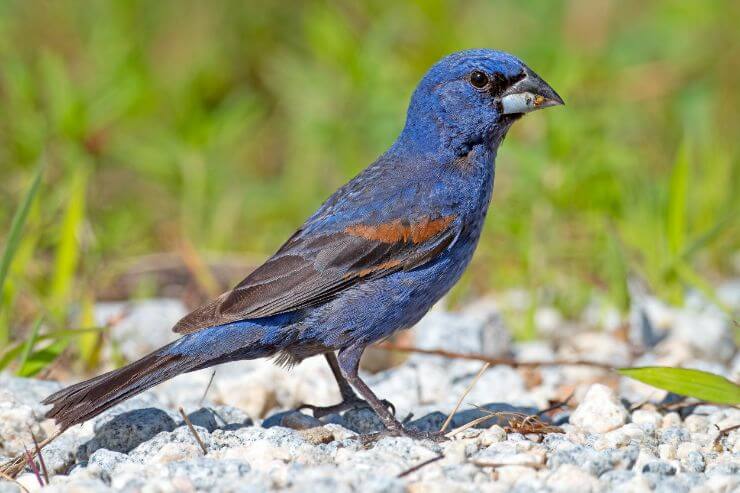
Blue Grosbeaks nest in dense brush or tangles along field edges and roadsides. Females build a cup of twigs, grass, and rootlets hidden in thick cover. Males sing steadily from exposed perches just above, defending the nesting territory with rich, musical phrases that drift out across sunny fields.
Their diet includes grass seeds, grains, and many insects during breeding. Blue Grosbeaks often forage low among tall weeds or along roadside ditches, moving slowly with an alert, watchful demeanour. Their heavy bills crack seeds easily, and they occasionally rise to snap up insects in midair.
Blue Grosbeaks are expanding their range northward, including parts of Maryland. They remain locally uncommon but are increasing gradually as old fields and shrubby habitats mature. Conservation focuses on maintaining early successional areas and monitoring breeding populations to track this slow but encouraging spread.
7. Belted Kingfisher
- Scientific name: Megaceryle alcyon
- Life span: Up to 14 years
- Size: 11–14 in (28–35 cm)
- Weight: 4.9–6 oz (140–170 g)
- Wingspan: 19–23 in (48–58 cm)
- Status: Least Concern
- State status: Breeding and common
- Migratory behaviour: Most stay year-round if water doesn’t freeze.
The Belted Kingfisher is found throughout most of North America near rivers, lakes, and coastal waters. It has slate-blue upperparts, a large shaggy crest, and a white collar around the neck. Females are distinctive, with an extra rust-coloured band across their bellies that males lack. Belted Kingfishers often sit motionless on branches overhanging the water before plunging straight down to catch fish. Their loud rattling calls echo along shorelines and are unmistakable once you’ve heard them.

Belted Kingfishers dig burrows into steep riverbanks or sandy cliffs. Both sexes excavate a long tunnel that ends in a nesting chamber hidden from predators and the weather. They often reuse the same site each year if the bank remains stable and undisturbed.
They eat small fish and aquatic creatures, diving headfirst into water from a favourite perch. After surfacing, they fly back to the branch, beating the fish against it before swallowing. Their rattling calls announce their presence as they patrol streams and ponds in search of the next meal.
Kingfishers remain widespread and secure in Maryland. Clean waterways and undisturbed nesting banks are critical to their success. Conservation focuses on protecting riparian habitats, monitoring water quality, and ensuring development doesn’t destroy the sandy cliffs these birds depend on for breeding.
Where to find Blue birds in Maryland
Finding blue birds in Maryland can be a rewarding experience, whether you’re an experienced birder or just someone who enjoys being outside. Early morning is usually the best time to look, when birds are singing and moving actively. Bring a pair of binoculars and walk slowly, pausing often to watch for flashes of color in the trees or along the edges of fields.
Eastern Bluebirds are common in open spaces with scattered trees and nest boxes. Look along fence lines and meadows, where they often perch on wires. Indigo Buntings prefer shrubby areas and clearings where they sing from high branches. Tree Swallows and Barn Swallows can be seen swooping gracefully over ponds and fields in search of insects. Near rivers, you might spot the Belted Kingfisher hovering before diving straight down to catch a fish.
Four great places to see blue birds in Maryland include Patuxent Research Refuge, which has diverse habitats for swallows, kingfishers, and buntings. Cromwell Valley Park near Baltimore offers fields and hedgerows that attract bluebirds and grosbeaks. Assateague Island National Seashore is excellent during migration, when warblers pass through coastal habitats. Finally, Soldiers Delight Natural Environment Area west of Baltimore has open serpentine barrens and wood edges that draw Indigo Buntings and Blue Grosbeaks.
Conclusion
Blue birds add brightness and life to Maryland’s landscapes, whether you’re near a quiet pond, a busy field, or a wooded trail. From the shimmering Indigo Bunting to the watchful Belted Kingfisher, each species offers something unique to enjoy. Learning to recognize their songs, colors, and habits helps you feel more connected to the places you visit.
By protecting healthy habitats and planting native plants, we can make sure these beautiful birds continue to thrive. With just a little attention and curiosity, you’ll discover how much joy blue birds bring to every season spent outdoors in Maryland.

